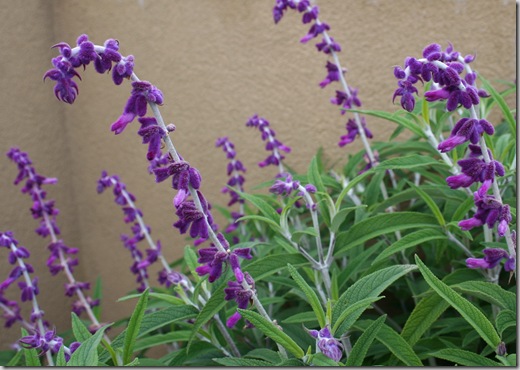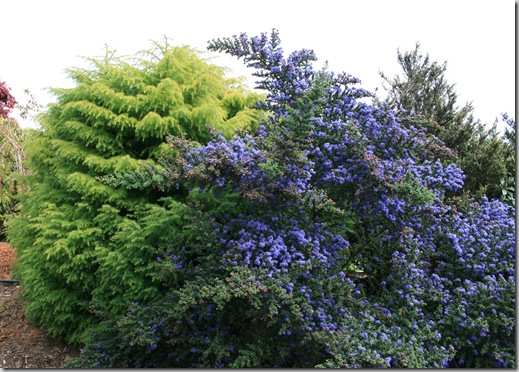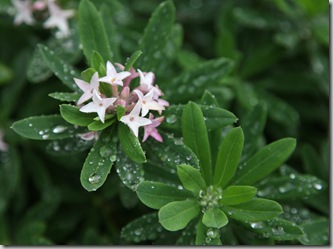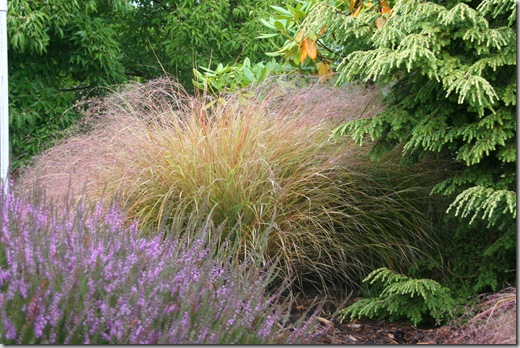Recently I read an article on Sunset’s website, suggesting that we all rush out and buy those discounted perennials to plant for fall. We all know by now that fall planting is a great idea, but is fall really the best time to plant everything, even perennials?
Many perennials don’t actually live all that long (I’m lookin’ at you, Gaura!), and some are sensitive to frost or the coastal Pacific Northwest’s rainy winters, so coddling them through the cold season can be an exercise in waiting and hoping, or if you really care about them, covering the tender ones in a protective frame of some kind.
The article suggested planting Salvia leucantha/ Mexican Bush Sage, Aster x frikartii, Echinacea/ Coneflower, Gaura lindheimeri, Gaillardia, Rudbeckia/ Black-Eyed Susan, Salvia elegans/ Pineapple Sage, and Eryngium/ Sea Holly now – all of which can die in our winters even when well-established.

Here’s the deal:
Anything short-lived, frost-tender, or that molds in the rain is best planted after frost in spring, so the plant has time to develop a healthy root system before being asked to tolerate uncomfortable conditions. If their tops freeze next year, they’ll still have a year’s worth of root growth underground to spring back from.

In the rainy/ chilly Maritime Pacific Northwest, DON’T plant these in fall:
Tibouchina urvilleana/Purple Princess Flower – frost-tender
Citrus Trees – Lemons and Limes bear well in winter, but they often lose the outer two feet of foliage to frost damage each year.
Loropetalum chinense/ Fringe Flower – frost-tender
Tree Fern/ Dicksonia antarctica – frost-tender (usually survives first winter but looks sorry for itself!)
Mallow/ Lavatera – frost-tender
Coleonema/ Breath of Heaven – frost-tender

Pennisetum setaceum ‘Rubrum’/ Purple Fountain Grass – frost-tender and doesn’t care for rain, so give it good drainage!
Passiflora/ Passionflower Vines – frost-tender
Salvia/ Sages of any kind – the culinary sages seem the most tolerant of winter, but all the ornamentals are tender enough it’s best to let them establish a year. If they grow big the first year, the outer foliage can protect the inner stems in case of a bad frost.
Pelargoniums/ Grandma Geraniums (Hardy Cranesbills/ actual Geraniums are fine to plant now) – frost-tender
Creeping Rosemary – they’ve been getting a disease which has been killing off selected branches in the wettest parts of winter, so I’d let them get large all summer first
Fuchsias – frost-tender (I have had some luck in planting the tiny-flowered Fuchsia thymifolia under protected eaves for winter color, but I wouldn’t try that with the big froofy hybrids!)
Abutilons/ Flowering Maples – frost-tender (once again, under a protected eave they can sometimes attract hummingbirds through the winter)
Persicaria/ Fleeceflower – frost-tender
Calla Lilies (the huge sturdy white ones that grow everywhere are fine (Zantedeschia aethiopica), but don’t bother with the fancypants hybrids right now) – frost-tender
Cosmos atrosanguineus/ Chocolate Cosmos – frost-tender
Agapanthus/ Lily of the Nile – frost-tender
Scabiosa, Rudbeckia, Ginger, Delphineum, Gaillardia, Echinacea, Asters (great for a fall display, but may not live over), Coneflower, Sollya/ Australian Bluebell (hates wet), Gaura, Eryngium, Kangaroo Paw, Kniphofia/ Red Hot Poker, or any other flowering perennial or shrub which you suspect may be either sensitive or short-lived.

DO plant these:
Hardy trees and shrubs, including Grevillea, Red-Twig Dogwood, Hydrangea, Tea Tree, Rhododendrons, Star Magnolia, Ceanothus/ California Lilac, Japanese Maple, Camellia, Pieris, Daphne, Huckleberry, Spirea, Conifers
Hardy edibles including bare-root fruit trees, Blueberry, cane-growing berries like Raspberry and Loganberry, CA native currant Ribes sanguineum (Bare-root plants arrive in January)
Most ornamental grasses including Miscanthus, Stipa arundinacea, Nassella tenuissima, Phormiums/ Flax, Chondropetalum, Hakonechloa/ Forest Grass, Acorus (Check out this article for winter-interest grasses)
Bare-Root Roses (arrive in nurseries in December/ January)
Sturdy perennials and small shrubs including Astilbe, Shasta Daisy, Lavender, Culinary Oregano, Sedum ‘Autumn Joy’, Hellebore, Hardy Cranesbill/ Geranium ‘Rozanne’ and others, Nepeta faassenii/ Catmint, Euphorbia, Heuchera
If you found this post helpful, check out these articles with my favorites to plant now:
Unusual Rhododendrons for the Pacific Northwest
Showy Trees for Winter Interest
[print_link]
10 responses to “Delicate Flowers: What NOT to Plant in Fall”
It’s always so enlightening reading about gardening in other regions! I’m a big fall planter (though, admittedly, mostly shrubs), and am very intrigued by some of the things that shouldn’t be planted in fall in the Pacific Northwest: specifically, Scabiosa, Rudbeckia, Gaillardia, Echinacea, and Asters. All of these are entirely winter-hardy here in zone 6 (in the new scheme of things) southeastern Michigan; in fact many self sow themselves over the winter. While it truly is a bit late now in my area to plant them (not enough time to get their roots established before the ground freezes), I would have comfortably planted those through mid-late October. I’ve never lost any of these over the winter (um, unless some critter ate them in early spring). I guess wet winters have an entirely different effect on plants than a really cold winter where the plants go entirely formant/die back. Does the foliage remain where you are? Perhaps that’s the difference. As always, interesting post!!
.-= Monica the Garden Faerie´s last blog ..It’s All Good =-.
Yep, Monica! It’s all our blasted rain!! Those guys just tend to rot. It’s possible they also need a good cold snap to force them into dormancy or kill some soil-borne disease they get, but in any case – they do not do well here over the winters! The foliage does stay aboveground here on most of these plants.
I’m jealous of your rudbecks and echinaceas – but then – I am sure you’re jealous of my princess flowers and other tender beauties!
How does agastache do for you? I’m like an old man with a gripe, grumbling about it every time the subject of tricky plants comes up. I invested heavily in them a few summers ago, gave them the best of everything and they all conked out over the winter. I now consider them annuals in my Zone 7b spot. And did I tell you about my rheumatism?
.-= Daffodil Planter´s last blog ..Do my incense-cedars work for Goldman Sachs? =-.
LOL, Daff, my aching hips!! (I wish I were joking!)
Agastache seem to hate our winters too. I’ve had one live over, falteringly, and conk out the next year. I figured it was our rain that they hated, but you don’t get as much rain as we do here on the coast, do you? Everyone talks about them like they’re so easy – but never anybody from around here that I have heard.
Your list is very intriguing, and I am beginning to think that we, too, here in Southern California, should rethink the generally held belief that fall is the best planting season. We don’t usually encounter the problem of too much rain – it’s the Santa Ana winds that dry out the newly planted shrubs and perennials, and of course it’s the perennials that suffer most, and since the rains haven’t really started yet it’s hard to keep them moist enough to withstand the drying strong winds. How often have I watched my new plantings wither, and had trouble adjusting the irrigation to cope with the drought when the cooler temperatures lure us into believing that we can reduce irrigation frequence and length. Especially now with our watering restrictions, planting should really be held off until the rains start which usually are more reliable in early spring. Thanks for this thorough list!
.-= Christiane Holmquist´s last blog ..pondsage =-.
That is an awesome point, Christiane, about holding off planting till the more reliable spring rains start hitting. “Fall” usually gets us a couple of rains but it is mostly sprinkles. Just yesterday I pulled out some ancient heathers and found they were bone dry underneath despite having a heavy rain two days earlier!! So I think you’re right – the soil isn’t really drenched now and anything planted right now might need supplemental water.
I’m still planting trees and shrubs, just holding off on the most delicate ones… like you said, it really is the perennials that suffer the most.
Don’t feel too badly about the agastaches, the little buggers self-sow until you want to shoot yourself.
.-= Sonia Simone´s last blog ..What Makes Marketing Hard? =-.
Sonia! Here, in my humble gardening blog! Thank you so much for stopping by Sonia, I’m honored.
I guess Daff and I should quit bellyaching about not having the agastaches then if they are thuggish – but it’s always the things you can’t grow that you long for the most. I bet you grow great hybrid Clematis as well. Stupid things mold here. Great flowers on moldy unhappy leaves. Blech.
Always so interesting seeing what makes a different climate and a different planting program. I hadn’t thought about wind as a factor, but of course it is, since it increases transpiration and the plants dry up, and in the case of small plants, croak.
For us in N Cal it’s hard to predict when the reliable rains will come – sometimes it’s fall, sometimes winter, sometimes spring – but any of those might be dry in a given year, and in drought years a couple of them will be. It’s one of the most interesting thing about garden blogs, I think, seeing how we all cope with our different climes – and long for those ungrowable plants which somebody across the country may regard as a loathsome weed. (I remember being amused the first time I heard the Brits have carefully bred many varieties of GOLDENROD, a pestiferous allergy-producing weed to many, though not to me.)
.-= Pomona Belvedere´s last blog ..Rose Hips =-.
This has much information which is good for me. Thanks for this post I won’t be needing more research on what to plant for the fall season. Thanks a lot!
.-= Grasshopper´s last blog ..Wordless Wednesday – Tiger Swallowtail Butterfly =-.